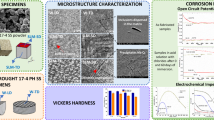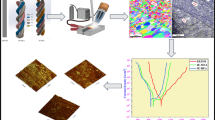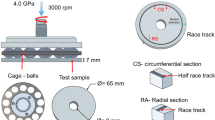Abstract
Variable polarity, gas-tungsten arc welds were made on roll-cast AZ31 magnesium sheet using AZ61 filler metal. Weld and base metal coupons were evaluated in air and buffered saline solution to produce S-N fatigue curves. When tested in air, both welds and base metal demonstrated a fatigue limit, with the weld failing in the heat-affected zone (HAZ) at a reduced fatigue life. In saline solution at low cycle-high stress, there was a notable reduction in fatigue life attributed to crack initiation at corrosion pits. At high cycle-low stress, failure of welds shifted to the base metal where there was severe corrosive attack and reduced load bearing cross-section. Controlled immersion tests confirmed this shift in attack from the HAZ and weld metal to the base metal at long times. Although polarization curve measurements showed the weld metal to be the most reactive (i.e. more negative corrosion potential), the gradual formation of a stable passive film eventu-Bally protects the weld metal and HAZ from further attack. By alloying more Al in the anodic weld metal (e.g. increasing AZ61 filler dilution), its corrosion potential is shifted closer to that of the base metal and corrosive attack is minimized. Higher Al content also results in higher amounts of eutectic β, and smaller grain size and higher hardness in the weld metal, matching that of the base metal.
Similar content being viewed by others
References
Landkof B.: Magnesium alloys applications, in Magnesium Alloys- Science, Technology and Applications, Israeli Consortium for Development Mg Tech. (Pub.), 2004, pp. 293-316.
Engl B.: A new technology for magnesium sheet production, Light Metal Age, 2005, vol. 63, no. 5, pp. 14–19.
Welding of magnesium alloys, in ASM Handbook: Welding, Brazing and Soldering, 1993, vol. 6, ASM International, Materials Park, Ohio, pp. 772–782.
Rethmeier M., Kleinpeter B. and Wohlfahrt H.: MIG welding of magnesium alloys metallographic aspects, Doc. IIW-1619, Welding in the World, 2004, vol. 48, no. 3/4, pp. 28–33.
Jüttner S.: Return of the light alloy brigade, Welding and Metal Fabrication, 1998, vol. 66, no. 1, pp. 11–5.
Aochi M., Fujii N. and Yasuda K.: Study of the basic welding characteristics of Mg alloy, Welding International, 2004, vol. 18, no. 12, pp. 944–949.
Aochi M., Fujii N. and Yasuda K.: Study of the welding procedure for production of Mg alloy joints for practical use, Welding International, 2004, vol. 18, no. 12, pp. 950–955.
Vaidya W.V., Horstmann M., Seib E., Toksoy K. and Kocak M.: Assessment of fracture crack propagation of laser beam and friction stir welded aluminium and magnesium alloys, Advanced Engineering Materials, 2006, vol. 8, no. 5, pp. 399–406.
Sonsino C.M., Hanselka H., Karakas Ö., Gülsöz A., Vogt M. and Dilger K.: Fatigue design values for welded joints of the wrought magnesium alloy AZ31 (ISO-MgAl3Zn1) according to the nominal, structural and notch stress concepts in comparison to welded steel and aluminium connections, Doc. IIW-1857, Welding in the World, 2008, vol. 52, no. 5/6, pp. 79–94.
Liu L.M., Song G. and Zhu M.L.: Low-power laser/arc hybrid welding behavior in AZ-based Mg alloys, Metallurgical and Materials Transactions A: Physical Metallurgy and Materials Science, 2008, vol. 39, no. 7, pp. 1702–1710.
Tsujikawa M., Somekawa H., Higashi K., Iwasaki H., Hasegawa T. and Mizuta A.: Fatigue of welded magnesium alloy joints, Materials Transactions — JIM, 2004, vol. 45, no. 2, pp. 419–422.
Rethmeier M., Wiesner S. and Wohlfahrt H.: Influences on the static and dynamic strength of MIG-welded magnesium alloys, Magnesium Alloys and Their Applications, Wiley-VCH, 2000, pp. 200-204.
Kleinpeter B., Rethmeier M., Wohlfahrt H. and Dilger K.: Fatigue strength of welded wrought magnesium alloys, Magnesium Alloys and Their Applications 2003, Wiley-VCH, pp. 908-916.
Rethmeier M.: MIG-Schweißen von Magnesiumlegierungen, MIG welding of magnesium alloys, Thesis Dissertation, TU Braunschweig, 2003, Shaker Verlag (in German).
Berger C., Eppel K., Ellermeier J. and Troßmann T.: Investigation of the corrosion of welded magnesium joints, Magnesium Alloys and Their Applications, 2007, Wiley-VCH, pp. 734-742.
Cross C.E., Ben-Hamu G., Eliezer D. and Xu P.: Corrosion-fatigue of AZ31 wrought magnesium weldments, Magnesium Alloys and Their Applications, 2007, Wiley VCH, pp. 727-733.
Wilsdorf R., Pistor R., Sixsmith J.J. and Jin H.: Welding aluminium pipe and tube with variable polarity, Welding Journal, 2006, vol. 85, no. 4, pp. 42–43.
Aghion E. and Bronfin B.: Physical metallurgy of Mg alloys, in Magnesium Alloys-Science, Technology and Applications, Israeli Consortium for Development Mg Tech. (Pub.), 2004, pp. 7-43.
ASTM Standard E466-02: Standard practice for conducting force controlled constant amplitude axial fatigue tests of metallic materials, 2002.
Ben-Hamu G., Eliezer D., Cross C.E. and Böllinghaus Th.: The relation between microstructure and corrosion behavior of GTA welded AZ31B magnesium sheet, 47 Materials Science and Engineering A, 2007, vol. 452-453, pp. 210–218.
Stern A. and Munitz A.: Partially melted zone microstructural characterization from gas-tungsten arc bead on plate welds of magnesium AZ91 alloy, Journal of Materials Science Letters, 1999, vol. 18, no. 11, pp. 853–855.
Song G. and Atrens A.: Understanding magnesium corrosion, Advanced Engineering Materials, 2003, vol. 5, no. 12, pp. 837–858.
Busk R.: Magnesium alloys, Treatise on Materials Science and Technology, 1989, vol. 31, pp. 663–679.
Winzer N., Xu P., Bender S., Gross T., Unger W.E.S. and Cross C.E.: Stress corrosion cracking of gas-tungsten arc welds in continuous-cast AZ31 Mg alloy sheet, Corrosion Science, 2009, vol. 51, no. 9, pp. 1950–1963.
Michel S.A., Kieselbach R. and Figliolino M.: Environmental and frequency effects on fatigue crack growth rate and paths in aluminium alloy, Fatigue and Fracture of Engineering Materials and Structures, 2005, vol. 28, no. 1–2, pp. 205–219.
Author information
Authors and Affiliations
Corresponding author
Rights and permissions
About this article
Cite this article
Cross, C.E., Xu, P., Winzer, N. et al. Corrosion and corrosion-fatigue of AZ31 Magnesium weldments. Weld World 55, 40–47 (2011). https://doi.org/10.1007/BF03321306
Published:
Issue Date:
DOI: https://doi.org/10.1007/BF03321306




